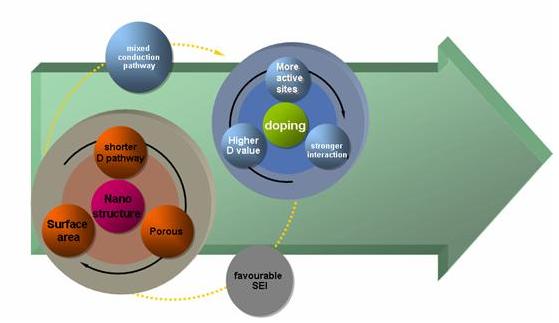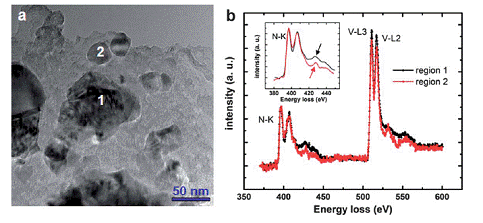The exploration of high-performance electrode materials for electrochemical energy storage system has aroused increasing scientific interests. Professor CUI Guanglei, group leader of Biomimetics Energy and System Group at Qingdao Institute of Bioenergy and Bioprocess Technologyand his research group have made a series of progresses in this area.
A typical reaction process of electrochemical energy storage system involves three decisive mechanistic steps (Li-ion batteries for example): (1) Li+ motion in the electrolyte; (2) Li+ transfer between electrolyte and electrode interface; (3) chemical diffusion of Li+ in the electrode materials (Fig.1). The third step, a rate-determining one, will have to accord with the equation τeq= L2 /2D, where τeq is storage time, L is the sample thickness, and D is chemical diffusion coefficient. Therefore, compared to micrometer-sized materials, nano-material shortens the diffusion length of Li+ in the electrode, enhancing the rate capability of the cell. (Joachim Maier et al.)
Fig. 1 The three decisive mechanistic steps of Li+ transportation in Li-ion batteries
(By Prof. Joachim Maier).
Focusing on the design of mixed conducting (both ions and electrons) electrode, the construction of efficient transportation network and favorable electrolyte/electrode interface, CUI and co-workers have developed kinds of high-performance nano-structured electrode materials for electrochemical energy storage (Fig.2). As titanium nitride (TiN) possesses excellent electronic conductivity and superior chemical resistance properties with lowcost, nanostructured TiN and TiN based nanocomposite, such as TiN mesospheres (ACS Appl. Mater. Interfaces, 2011, 3, 93-98), TiN/MnO2 coaxial nanowire arrays (Energy Environ. Sci., 2011, 4, 3502–3508), and TiN/VN coaxial fiber (ACS Appl. Mater. Interfaces, 2011, DOI:10.1021/am200564b) have been fabricated for capacitive energy storage. Results have indicated that these electrode materials can promote charge transportation for both ions and electrons and deliver considerable capacity. These materials also show promising specific capacitance and rate capability. Among them, TiN mesospheres can deliver a higher energy density of 45.0 Wh kg−1 at a power density of 150 Wkg−1.

Fig. 2 Concept of designing mix conducting (ions and electrons) electrode materials
(By Prof. CUI Guanglei)
Rechargeable lithium-O2 batteries have aroused increasing scientific interests, as their super-large energy density is highly desirable for future power system in electric vehicles. CUI et al. has designed a hybrid material of molybdenum nitride/nitrogen-doped graphene nanosheets for O2 cathode in Li-O2 cell. This hybrid cathode exhibits high electrocatalytic activity and smaller discrepancy between the charge and discharge curves, which enhances the round-trip efficiency (Chem. Com. 2011, DOI:10.1039/C1CC14427H). Furthermore, a novel bio-Li-air battery has also been constructed based on an enzyme-TiN nanorod arrays cathode (Biosensors and Bioelectronics 26 (2011) 4088–4094).
Working with Prof. J.Maier and Prof. M. Antonietti at the Max Planck Institute, CUI et al. have further investigated the fundamental mechanisms of lithium storage. In this study, mesoporous carbon nitrides have been used as a reactive template, and composites of titanium vanadium nitride and carbon with multiple-interfaces inside have been synthesized. This material exhibits a promising capacity of interfacelithium storage and also an impressive rate capability (ChemPhysChem, 2010, 11, 3219–3223).
CUI’s group has also investigated the lithium storage properties and the corresponding interface dynamics of nitrogen doping of the graphene, by cooperating with Prof. Li-Quan Chen, Lin Gu, et al., from Institute of Physics, Chinese Academy of Sciences. The results showed that nitrogen doping of graphene nanosheets provide more active sites of lithium and greatly reduce the interface impedance (J. Mater. Chem., 2011, 21, 5430-5434). The further work also reveals that the generated Li3N (fast ion conductor) and its derivatives materials at interface endow the interface resistance reduction and favorable SEI (solid-state electrolyte interface) formation happen. Through the characterization of EELS, XRD and HRTEM., it has been found that VN/GNS hybrid was constantly activated and reacted with lithium, leading to continuous increasing of the capacity (J. Mater. Chem., 2011, 21, 11916-11922). An electrode material with high-power lithium-ion capacitor has also been developed (China patent ZL201010104003.1) based on this mechanism.

Fig. 3 TEM (left) and EELS (right) analyses of the VN samples after cycles, indicating that lithium ions were incorporated into the vanadium nitride by extended cycling
(By Prof. CUI Guanglei)
The above research works have been financially supported by the Ministry of Science and Technology of China, National Scientific Foundation of China, Chinese Academy of Sciences, and Shandong Provence.
Contact:
Prof., Dr. CUI Guanglei, cuigl@qibebt.ac.cn
References:
1. S. Dong, X. Chen, L. Gu, X. Zhou,| H. Xu, H. Wang, Z. Liu, P. Han, J. Yao, L. Wang, G. Cui, L. Chen, Facile Preparation of Mesoporous Titanium Nitride Microspheres for Electrochemical Energy Storage, ACS Appl. Mater. Interfaces 2011, 3, 93-98.
2. S. Dong, X. Chen, L. Gu, X. Zhou, L. Li, Z. Liu, P. Han, H. Xu, J. Yao, H. Wang, X. Zhang, C. Shang, G. Cui, L. Chen, Coaxial MnO2-Titanium Nitride Nanotube Array for High-rate Electrochemical Capacitive Energy Storage, Energy Environ. Sci. 2011, 4, 3502–3508.
3. X. Zhou, C. Shang, L. Gu, S. Dong, X. Chen, P. Han, L. Li, J. Yao, Z. Liu, H. Xu, Y. Zhu, G. Cui, Mesoporous Coaxial Titanium Nitride-Vanadium Nitride Fibers of Core-shell Structures for High-Performance Supercapacitors, ACS Appl. Mater. Interfaces, 2011, 3, 3058–3063.
4. S. Dong, X. Chen, K. Zhang, L. Gu, L. Zhang, X. Zhou, L. Li, Z. Liu, P. Han, H. Xu, J. Yao, C. Zhang, X. Zhang, C. Shang, G. Cui, L. Chen Molybdenum Nitride based hybrid Cathode for Rechargeable Lithium-O2 Batteries, Chem. Common. 2011, Accepted, DOI: 10.1039/ C1CC14427H
5. S. Dong, X. Chen, L. Gu, L. Zhang, X. Zhou, Z. Liu, P. Han, H. Xu, J. Yao, X. Zhang, L. Li, C. Shang, G. Cui, A biocompatible titanium nitride nanorods derived nanostructured electrode for biosensing and bioelectrochemical energy conversion, Biosens. Bioelectron., 2011, 26, 4088.
6. G. Cui, L. Gu, A. Thomas, L. Fu, P. A. van Aken, M. Antonietti, J. Maier, A Carbon/Titanium Vanadium Nitride Composite for Lithium Storage, ChemPhysChem, 2010, 11, 3219 – 3223.
7. H. Wang, C. Zhang, Z. Liu, L. Wang, P. Han, H. Xu, K. Zhang, S. Dong, J. Yao, G. Cui, Nitrogen-doped graphene nanosheets with excellent lithium storage properties, J. Mater. Chem., 2011, 21, 5430-5434.
8. K. Zhang, H. Wang, X. He, Z. Liu, L. Wang, L. Gu, H. Xu, P. Han, S. Dong, C. Zhang, J. Yao, G. Cui, L. Chen, A hybrid material of vanadium nitride and nitrogen-doped graphene for lithium storage, J. Mater. Chem., 2011, 21, 11916-11922.

